MADSEN'S SKUNK
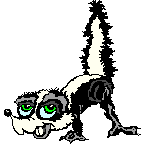
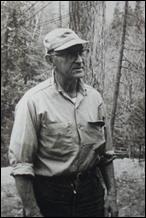 Earl Madsen [1895-1964]
Earl Madsen [1895-1964]
Earl Madsen is a name that should not be a stranger to anyone. He was a famous Michigan river guide, a river boat builder and legendary tyer of the Au Sable River in Grayling, Michigan. He is credited with being Michigan's first commercial tyer and the first person to ever tie deer hair parallel to the hook shank. Our pattern today, the Madsen's Skunk has long been attributed to Earl and will probably remain that way. In actuality was created by James (Jerry) B. Webber, who was the Director of Merchandising for the J. L. Hudson Stores and the nephew of J. L. Hudson. Jerry was a member of the Rainbow Club on the Au Sable River, in Grayling, Michigan. It was developed in the 1940s. It not only is used for trout but, happens to be an excellent pan fish fly in smaller sizes and a slayer of bass in larger sizes.
It's a tremendous all-purpose fly that imitates hoppers, crickets, spiders and stone flies. It can be used at any time during the day and any time of the year, under all circumstances. It is a must carry fly! This is said to have been the first fly to incorporate rubber legs into a fly pattern.

Materials:
- Hook: Streamer Size 6-16
- Thread: Black, 6/0
- Tail: Gray Squirrel Tail
- Legs: White Rubber, approx. 1 ½" long
- Body: Black Chenille
- Wing: Natural or White Deer Hair
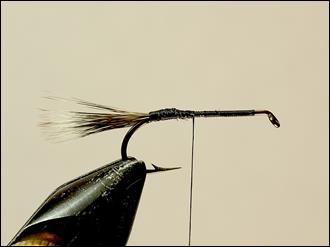 The original skunk was tied in a size 8.
The original skunk was tied in a size 8.
Lay in a good base of thread. Tie in your
tail of squirrel tail fibers and secure with thread. The more popular modern version uses white calf tail for the tail.
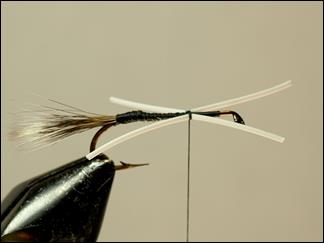 Tie in your legs, just slightly forward of the
Tie in your legs, just slightly forward of the
center of the hook shank. The traditional skunk used white legs while many of the more modern versions use barred rubber legs.
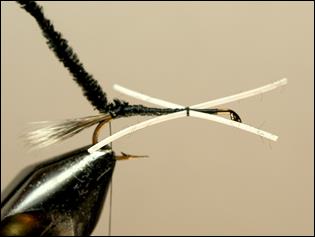 Secure your chenille at the bend of the hook.
Secure your chenille at the bend of the hook.
The more modern versions of the skunk are also tied with yellow chenille.
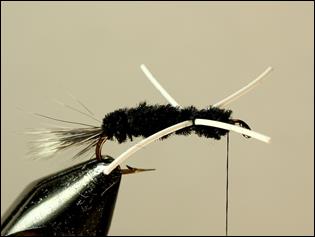 Wrap your chenille forward, wrapping it in
Wrap your chenille forward, wrapping it in
and out and around the legs as necessary, in order to keep the X shape.
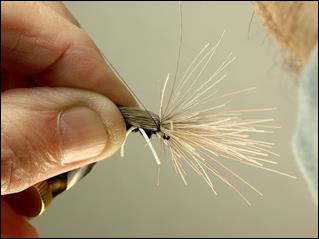 The wings were traditionally deer hair,
however in the modern versions, elk hair
can be substituted. Secure the wing behind the eye. Now, pull your thread back across the body as if to begin to make an X pattern about two eye widths back. Now, re-secure the wing. Then bring the thread back forward to complete the X pattern. This forms a small shellback area which is characteristic of the skunk pattern.
The wings were traditionally deer hair,
however in the modern versions, elk hair
can be substituted. Secure the wing behind the eye. Now, pull your thread back across the body as if to begin to make an X pattern about two eye widths back. Now, re-secure the wing. Then bring the thread back forward to complete the X pattern. This forms a small shellback area which is characteristic of the skunk pattern.
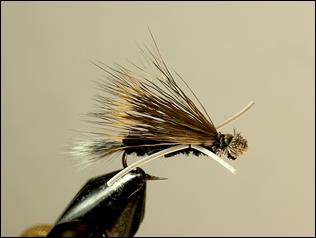 Secure your thread. Trim the head to form a knob. Be generous with head cement.
Secure your thread. Trim the head to form a knob. Be generous with head cement.
The rubber used for the legs in the original pattern most probably came from old golf balls. The other story is that it came from old automobile seats. There are dozens of variations of this pattern. But in one form or another it's used all across America. The fly is also called the Michigan Skunk or the Au Sable Skunk.
See you on the water…..
Tom Deschaine
~www.michigandryflies.net~
For more great info, check out:
Beginning Fly Tying | Intermediate Fly Tying | Advanced Fly Tying.
